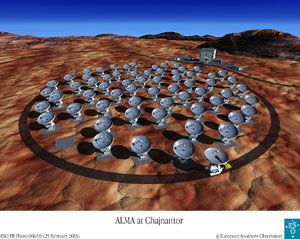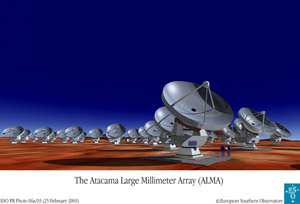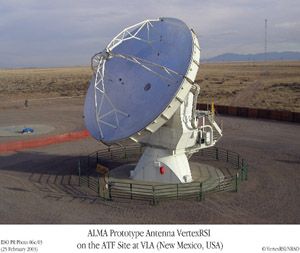The European Southern Observatory has given the green light for the world’s most powerful radio observatory. The ESO and the US National Science Foundation (NSF) have signed a joint agreement to construct and operate a millimetre and sub-millimetre wavelength telescope. At these wavelengths, which cross the boundary between the infrared and microwave portions of the electromagnetic spectrum, the key to understanding such processes as planet and star formation, the formation of early galaxies and galaxy clusters, and the formation of organic and other molecules in space, may be found.
The Atacama Large Millimeter Array (ALMA) will encompass sixty-four interconnected 12-metre radio antennae at the uniquely high altitude (5000m) of Chajnantor in the Atacama region of the Chilean Andes. The air here is very dry and so transparent to the crucial wavelengths ALMA will observe. It will be many orders of magnitude the power of any current radio telescope. Such telescopic power will be able to observe much of the energy in the Universe that is present at these low energies. It will see energy from cold cosmic dust and gases in interstellar space and the fading energy of ancient galaxies formed billions of years ago at the edge of the known Universe.

ALMA site
ESO Director General Catherine Cesarsky is highly enthused by the project. This agreement signifies the start of a great project of contemporary astronomy and astrophysics, she says. The ESO will represent its ten member countries and Spain, and work with many laboratories and institutes on the continent. With ALMA we may learn how the earliest galaxies in the Universe really looked, to mention but one of the many eagerly awaited opportunities with this marvellous facility, she adds.
In North America, the NSF also acts for the National Research Council of Canada and executes the project through the National Radio Astronomy Observatory (NRAO) operated by Associated Universities, Inc. (AUI). NSF Director Rita Colwell says that, With this agreement, we usher in a new age of research in astronomy.

A stylised view of ALMA
The Republic of Chile also stands to benefit from this astronomical Euro-American alliance as closer ties are wrought between her scientists and the international astronomers. Each of the two partners will foot half of the 650 million Euro/US Dollar bill for the telescope. The joint ALMA Board, established to oversee the project, met for the first time on 24th February.

Another view of ALMA
The President of the ESO Council, Piet van der Kruit suggests that ALMA heralds a breakthrough in sub-millimetre and millimetre astronomy, allowing some of the most penetrating studies of the Universe ever made. It is safe to predict that there will be exciting scientific surprises when ALMA enters operation. He adds that scientists from all over the world will use ALMA. Peer-reviewed proposals will help ensure that scientists get time on the telescope on the scientific merits of their project.

Piet van der Kruit
The prototype system will be in operation in 2004, while the initial scientific operation of the partially completed array will begin in 2007 and the final construction is destined for completion by 2011.

ALMA prototype
Further reading
European Southern Observatory
http://www.eso.org/public/
National Science Foundation
http://www.nsf.gov/
ALMA
http://www.eso.org/sci/facilities/alma/
National Radio Astronomy Observatory (NRAO)
http://www.nrao.edu/
Associated Universities, Inc.
http://www.aui.edu/
Piet van der Kruit
http://www.astro.rug.nl/~vdkruit/
Suggested searches
Radio astronomy